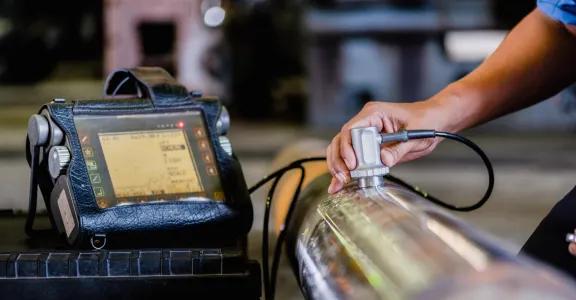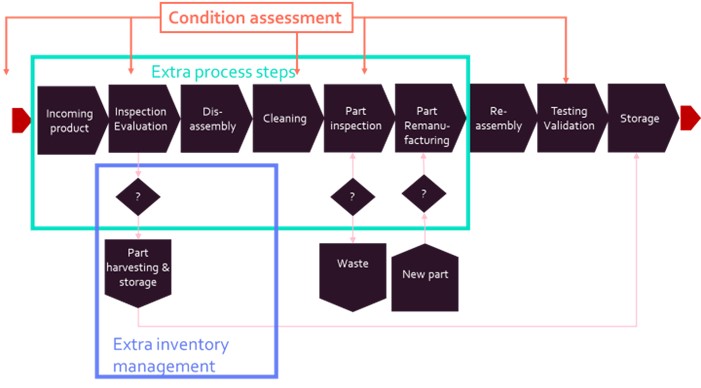A general roadmap for remanufacturing
Remanufacturing be profitable, though it comes with its set of prerequisites as is typically the case. In previous blogs, we described why customers choose remanufactured products and how you can do the cost-benefit analysis - even when data is missing. This article delves into condition assessment, exploring how to evaluate the state of incoming products (cores) and identify potential risks.
There are several ways to capitalise on the potential of the circular economy. The 'inner circles' of those circular strategies focus on reuse, repair, renovation, remanufacturing and repurposing. In this context, we employ 'remanufacturing' as a broad term to encompass those objectives.
Remanufacturing: more than re + manufacturing
There are a lot of differences between remanufacturing and regular production. The additional steps primarily occur at the start of the process, including acquiring products, inspecting products for remanufacturing, cleaning, disassembling, and upgrading the various components. A second key difference compared to regular production is the inventory management of reusable parts.
One of the new key challenges is condition assessment: assessing the quality (and hence value) of incoming products. That assessment helps you make a choice for each product: resell immediately, repair, upgrade or remanufacture, harvest parts, scrap and recycle, etc. Initiating this early in the process is crucial to avoid incurring unnecessary expenses.
Reducing risks
The quality of the cores will largely determine the profitability of your operational activities. It is therefore essential to define a clear scope.
In the first phase, you will find the most relevant strategy for your business context. What are the products you have at your disposal? What added value do they bring to what type of customer (selling second-hand, repairing, etc.)? Usually, the answers contain several overlapping strategies for different markets.
This is followed by tactical decisions. Which product groups are of interest to you? Which channels do you want to use to acquire cores? At what stage in the operational process will you inspect the cores? And using which tests? These last questions in particular are often tricky, as you only find the answers through practical experience. Therefore, practical experience is vital for optimising your operational process.
Condition assessment: roadmap
Below is a general roadmap for condition assessment in remanufacturing. As the exact approach depends heavily on your business context, we will publish separate - more detailed - articles with specific strategies and process steps in the future.
Step 1: Gathering information
Look for information and data that can help you assess the condition of an incoming product. Some examples:
- Usage data: How, for how long and where was the product used? Has it been repaired before? How many times?
- Design data: BOM (Bill of Materials), FMEA (Failure Mode and Effects Analysis) of the product design, quality data, any durability testing, etc.
- Historical data: Which repairs are most frequent, how do they happen and how much do they cost, ? What does the (remaining) lifespan look like? What are the sales statistics for spare parts?
Step 2: Testing and criteria setting
Choose one or more promising products and conduct some initial tests. The main purpose of this phase is to gather knowledge. Which criteria are important to consider for these products? What information can help you decide if items are valuable to your remanufacturing strategy? Consider, for example, the year of construction or the period of use.
Step 3: Condition assessment
Now it is time to determine when and how to test these criteria during the remanufacturing process. Year of construction, period of use and a photo of the product in its current state are often enough to make an initial decision - perhaps even before you get your hands on the product.
Additional inspections and testing of the product or associated components are often still indicated. Try to limit the number of additional inspections where possible to remain efficient. Some aspects you can easily see (wear or scratches), hear (an abnormal sound frequency) or smell (burnt electronics).
Step 4
It is crucial to assess your process even from the onset of your first remanufacturing orders. What works? What could be better? Is additional testing needed to avoid costs later in the process? So, this phase will never be fully completed. The more practical experience you build up, the more focused you can improve and streamline your process.
All steps in one templateWould you like to explore this roadmap in more detail? We have listed all the information, along with some key questions and answer boxes.
|
Remanufacturing: would it work for your business?Reuse, repair, upgrade ... Remanufacturing is just one of the possibilities. How can you be sure you are using the most appropriate strategy for your business? With the COOCK project 'CIRKEL - Remanufacturing as a lever for value creation in a circular manufacturing industry', supported by VLAIO, Sirris gives you the practical tools you need to mitigate the risks and increase the chances of success. This is how you can get started
|






